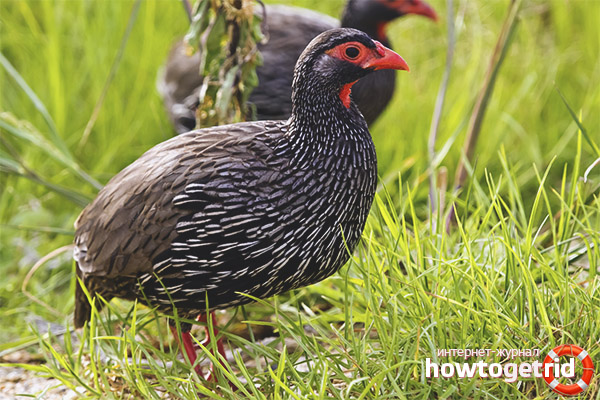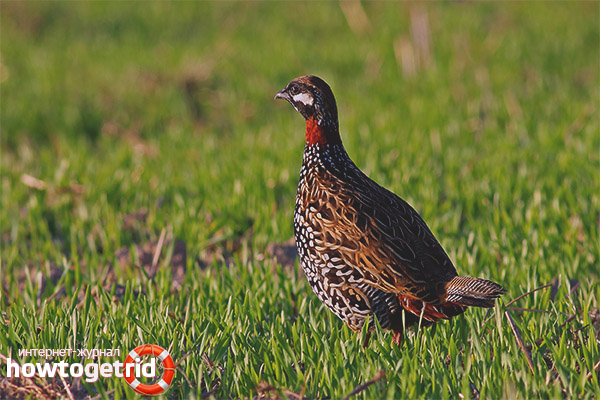The content of the article
Turach - a species of bird belonging to the family of chickens, having medium sizes (a little more than a gray partridge), weight - up to 500 g. A characteristic difference from other species is the unique color of the plumage (colorful and bright). Females, unlike males, have a paler plumage. The males have a gray-golden top of the head, characteristic white spots on the cheeks, the body is black with streaks. The neck of the turuch is decorated with an ornament of motley feathers of a chestnut color resembling a necklace in appearance.
Turach runs very fast, while stretching his neck and bending the front of the body to the ground. If a bird on its territory feels protected (dense thickets), then it can go quite long distances in search of the necessary food, while practically without using wings.
Having sensed even the slightest signs of danger, the turoch immediately tries to run away quickly, but only at the last moment uses his ability to fly, blowing into the air with a “candle” for several meters (up to 4 meters). As a rule, after a short flight in a horizontal position, it again falls into the thickets of reeds or thick grass.
Turach loves to bathe in the dust, during the extraction of food necessary for food or resting, he can sit on tree branches or shrubs. Bird singing is most often heard early in the morning. Turach’s cry is three-fold: a sharp short sound follows two longer ones.
This bird of the chicken family is very careful. But in nature reserves or in places where he does not feel danger, he is trusting.
The main signs and appearance of the bird
The plumage of the turach is quite dense, the color is variegated. Feathers of a brown-rusty hue adorn the bird's neck. The legs are red, the beak is black.
In its size, the turoch is slightly larger than the gray partridge. The bird is very careful, and when danger occurs, it immediately starts to run away. In flight, the turach makes frequent flapping wings, short-term flights.
Power Features
The basic diet of the turuch has not very significant differences from the food consumed by other birds belonging to the chicken family. This is mainly a variety of small insects, plant foods (grains, seeds, berries, young shoots of plants). As a rule, turuch finds most of its food on the surface of the earth. In search of berries, the bird, taking off, sits on the bushes.
Propagation Features
Francolin fishes are monogamous birds, which means that both parents in a pair take equal care of their offspring. The breeding season of birds of this species begins in early spring. The male, choosing a female, is almost all the time next to her, dissolving his colorful plumage, constantly bouncing and emitting characteristic invoking loud screams.
Basically, for nesting places, turuchs choose nooks under trees, in bushes, under cliffs. Note that turuchi, like ordinary guinea fowl, as a rule, do not build their own nests. For laying eggs, a small hole in the ground is used, the bottom of which is lined with dry vegetation, down and feathers. Egg laying time is from April to May.As a rule, the female takes care of from 7 to 15 eggs with a brown-olive hue with small white blotches. During the laying, the male is held near the nest in order to protect his girlfriend and future offspring in case of danger. The duration of incubation of eggs is about 3 weeks.
New offspring from the first weeks of their lives are quite active. In case of danger, parents hide their chicks, covering them with a wing. Under parental care, the brood of brood chicks remains up to three months, after which young birds fly apart and begin to lead an independent lifestyle.
Natural habitat

Turachi - birds that prefer to live in thickets of grass, shrubs. Willingly settle in thickets of reeds and tamarix, which are interspersed with open areas.
In the anthropogenic landscape, this chicken species as a place to live chooses thickets located along irrigation canals, cultivated fields, vineyards and orchards, and the outskirts of household plots.
Especially often thourach can be seen near human housing with the onset of the cold season. Wherever this species of bird lives, its representatives always need the proximity of water sources. Most often, turuch is found in southern Europe and Asia Minor.
Due to the low number of populations of this species, the value of turuch in the hunting industry is small. In addition, in some countries hunting for this bird is prohibited. You can distinguish turuch from other species of the chicken family by the characteristic dark-colored coloring of plumage.
Molting features
Such a process as molting turuch to this day is not fully understood. According to some studies, experts have revealed that the molting period is directly related to the breeding period. The longer the breeding season in a population of birds of a given species, the longer the molting time.
Adult birds, as a rule, begin to molt from mid-summer and by the beginning of autumn have fresh and bright plumage. Shedding of fly feathers is characterized by a change from the tenth to the first feather. The plumage of the chicks is replaced by the first annual outfit by the end of autumn.
Interesting facts about Turoch
As already mentioned, turoch is a bird that looks very similar to an ordinary partridge. However, unlike the latter, the turoch has a more slender physique, the head and beak are slightly longer.
Unlike other species of the chicken family, the female and the male turuch have the same color (the female is not as motley as the male). Spurs are present on the legs of the males.
The wings of the turach are rather short and rounded. The tail of the bird consists of 14 tail feathers.
Turuc has many natural enemies, as a rule, the laying of birds is destroyed by such animals as weasels, ferrets, foxes, jackals. In the event that he lives in the immediate vicinity of the farm, his nest can be ravaged by an ordinary yard cat. From birds of prey to the enemies of the turach can be attributed hawks and swamp moons.
Turach - although a rather rare bird, nevertheless, in some countries it is an object of sport hunting. Representatives of this species of chickens are hunted not only through dogs and hunting weapons, but also using hunting birds of prey. This is due to the fact that hunting for a bird with a dog can be complicated due to the dense vegetation and shrubs in which turuchi prefer to live. In this case, the best solution would be to use hunting birds of the hawk family.
Video: Turoch (Francolinus francolinus)










Submit